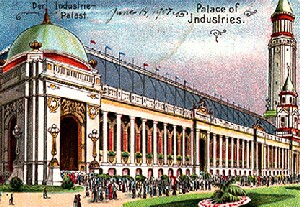|
1 |
 Copyright: Schmülling 1904 |
|
1 |
 Copyright: Schmülling 1904 |
The director of the exposition, Frederick J. V. Skiff, who in his opening speech emphasised the educational value of the exposition, developed a dual system of classification that was intended to improve the ordering systems of past expositions. A scientific classification of the world was intended to make humankind more decisive and bring forth "a balanced citizen who was receptive to the idea of progress". To educate this ideal citizen, the exhibits were organised in a way which demonstrated the sequence of the developments that stood for human progress. To do this a higher-ranking arrangement was used which was intended to illustrate the ideal of the "newly constituted human being". This portrait consisted of sixteen categories which corresponded to the departments of the exposition: education, art, the liberal arts and applied science at the fore, which - according to Skiff - were supposed to "arm humankind for the battle and prepare the good deeds of life". These were followed by the departments which were devoted to raw materials such as agriculture, horticulture, mining, forestry, fisheries and play, which illustrated how humankind had conserved the forces of nature for its purposes. The last three categories were devoted to anthropology, social economy and physical education. Although all categories were held to be of equal importance, one of the emphases in this exposition was on Ethnology and Anthropology, which corresponded to Skiff's definition of a world exposition: "a world exposition is a powerful museum of anthropology and ethnology, of humankind and its achievements."
| Year: 1904 | City: St. Louis | Country: USA |
| Duration: 30th April - 1st December 1904 | ||